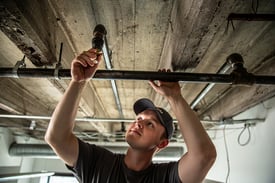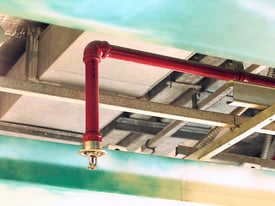
Fire sprinklers today are nearly synonymous with fire prevention and safety – it’s hard to imagine a building NOT having sprinklers that will go off if a fire breaks out.But of course, fire sprinklers didn’t always exist; they had to be invented. Over the few centuries, fire sprinklers have evolved from a very simple mechanism to the automatic, building-wide systems that we think of today.
In this blog, we’ll talk about the history of fire sprinklers, and what you can expect from your system in today’s day and age.
The first fire sprinkler systems
Sprinklers go back quite a ways – including all the way to the 15th century, with a design by Leonardo da Vinci in a kitchen. It was allegedly a little too effective, flooding the kitchen with water when a fire broke out.
In 1723, Ambrose Godfrey – a German-born apothecary – created a sprinkler system that used gunpowder to release a tank of fluid to extinguish a fire. This was considered the first “successful automated sprinkler system.”
The first fire sprinkler system with resemblance to those we know today appeared in 1812, when William Congreve put a sprinkler system into the Theatre Royal, on Drury Lane in London. This system featured one big pipe that connected to a large container for water, and then that pipe connected to a series of perforated pipes around the building. If a fire were to break out, water would be poured into the container, where it would travel through the large pipe and be dispersed through all the perforated pipes, flowing out in the form of a sprinkler.
While a bit simplistic, it was mostly effective in distributing water – which is of course the goal of any sprinkler system. One issue with perforated pipe systems however was uneven distribution, resulting in some areas being doused and others barely wet, as well as rust and debris blocking the holes in the pipes over time.
In coming years, more effective designs would emerge.
Different iterations
The first fire sprinklers required a person to actually fill the water for distribution. Over time, it became apparent that an automated system would be a far better option in an emergency, and thus the automatic sprinkler systems were born.
The first automatic sprinklers were produced in the 1860s. In 1872, the first patent for an automatic sprinkler system was awarded to inventor Philip W. Pratt. There were plugs to keep the valves on the sprinkler closed until it was needed, and when it turned out, the sprinkler featured a spinning head powered by water pressure, resulting in the sprinkler.
Improvements continued into the 1880s and 1890s. In 1881, the first heat-sensitive automatic sprinkler was designed, and in 1890, engineer Frederick Grinnell invented the glass disc sprinkler – which is essentially the same kind that is used today. Grinnell is considered to be the inventor of the first practical automatic fire sprinkler system.
Fighting sprinklers today
 Sprinklers have been used in buildings in the United States since the 1870s, with first installations happening in factories and other high-risk commercial buildings.
Sprinklers have been used in buildings in the United States since the 1870s, with first installations happening in factories and other high-risk commercial buildings.
Modern sprinklers often work with a heat-sensitive bulb or two-part metal link. These features act as a “plug,” keeping water from flowing. If the temperature increases enough, the “plug” bursts or breaks, and the water comes out as a sprinkler. Because of this, typically only sprinklers near the heat or fire will automatically turn on, which helps maximize the water pressure and minimizes potential water damage.
Today, sprinklers are installed in nearly all buildings, including non-industrial ones, such as schools, apartment buildings, hospitals and more. In fact, in the United States, sprinklers are now required in most new high rise and underground buildings. Sprinkler use is governed by building codes, and sprinklers may also be recommended by insurance companies in particular cases. Sprinklers are regulated by codes written by the National Fire Protection Association (NFPA).
If you’re not sure if your fire sprinkler system is up to code, we’re here to help. Our fire and life safety professionals will work with you to create a custom system designed to protect your people and property in the event of a fire emergency. You can get started with a consultation by reaching out to us at CertaSitePro.com.

